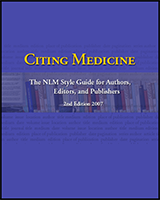Libraries & Collections
This guide is brought to you by:
![]()
How to cite and reference using the King's Numbered Style
When using the King's Numbered Style, in-text citations appear sequentially through the piece of work. The Reference List is then sorted in the order the citations appear.
Details of how to use in-text citations and how to build your reference list for books, articles, book chapters and webpages are provided on this page, If you need further guidance on how the reference for other materials should appear please see the linked style guide.
In-text citations
In the text of your piece of work, your first citation will appear as a number 1 in brackets like this: (1). Different sources will be numbered sequentially (2) throughout your work (3).
If you need to reference a source you've already used, you would use the number as the first time it was cited. E.g. if we wanted to cite our first source, the citation would appear as (1), even if it is appearing this second time after (2) or (3).
To reference multiple sources in the same place in the text, e.g. 2, 3, 4, 5 and 7, group them within the same brackets and use a hyphen to connect inclusive numbers (2-5, 7).
Page numbers should be included in in-text citations wherever it is necessary to indicate a specific part of the text, for example, for a quotation or paraphrase, e.g. (3, p. 125)
If you wish to list any further reading which you have not cited this can be included in a bibliography, ordered alphabetically by author. This is optional and will not be required in many cases. Please check the guidance you have been provided, or in your module handbook or with your assessor before using a bibliography.
Vancouver style manual
- (ebook) Citing Medicine, 2nd edition
 This the National Library of Medicine's Style Guide for citing and referencing in the Vancouver style.
This the National Library of Medicine's Style Guide for citing and referencing in the Vancouver style.
Vancouver has been chosen as the King's Numbered style.
Want to know more about the Author-Date, Footnotes, or Numbered style?
Need to know more about the Author-Date, Footnotes, or Numbered styles?
You can find videos to learn more about the styles in use and some quizzes you can take to make sure you know what you need to do, on KLaSS:
- KLaSS: Citing and Referencing Tools for your Studies
 Learn how to properly cite and reference your academic work at King's.
Learn how to properly cite and reference your academic work at King's.
Building your reference list in the King's Numbered style
A book reference:
(1) Ridley M. Genome: the autobiography of a species in 23 chapters. London: Fourth Estate Ltd; 1999.
(2) Hart I. The spread of tumours. In Knowles MA, Selby PJ, editors. Introduction to the cellular and molecular biology of cancer. Oxford: Oxford University Press; 2005. p. 278-88.
A journal article:
(3) Consonni D, De Matteis S, Lubin JH, Wacholder S, Tucker M, Pesatori AC, et al. Lung cancer and occupation in a population-based case-control study. Am J Epidemiol 2010 Feb 1;171(3):323-33
(4) Starr SR, Kautz JM, Sorita A, et al. Quality Improvement Education for Health Professionals: A Systematic Review. Am J Med Qual. 2016; 31(3):209–216. doi: https://doi.org/10.1177/1062860614566445
A note on journal titles: Numbered style requires you to abbreviate significant words in a journal title (see Abbreviation rules for journal titles) and omit other words, such as articles, conjunctions, and prepositions. For example, American Journal of Epidemiology becomes Am J Epidemiol.
A chapter in an edited book:
(5) Kone BC. Metabolic basis of solute transport. In: Brenner BM, Rector FC, editors. Brenner and Rector’s the kidney. 8th ed. Vol. 1. Philadelphia: Saunders Elsevier; c2008. p. 130-55.
(6) Hart I. The spread of tumours. In Knowles MA, Selby PJ, editors. Introduction to the cellular and molecular biology of cancer. Oxford: Oxford University Press; 2005. p. 278-88.
A web page:
(7) Macmillan Cancer Support. Lung cancer. [internet]. 2010 [cited 2010 Jan29]; [14 screens]. Available from: http://www.macmillan.org.uk/Cancerinformation/Cancertypes/ Lung/Lungcancer.aspx.
(8) AMA: helping doctors help patients [Internet]. Chicago: American Medical Association; c1995-2007. AMA launches exclusive partnership with the ReachMD Channel for medical professionals; 2007 Mar 26 [cited 2007 Mar 28]; [about 2 screens]. Available from: http://www.ama-assn.org/ama/pub/category/17469.html